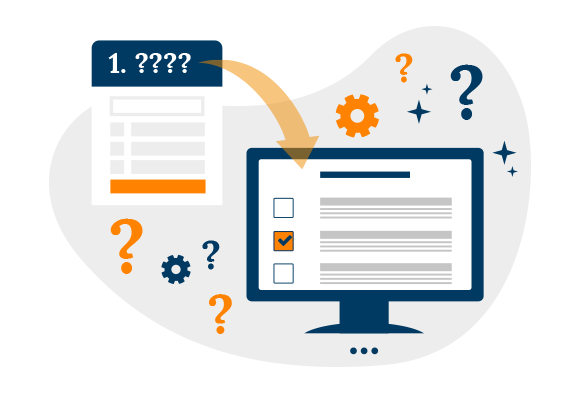Testing may be a crucial tool for determining student involvement and validating knowledge. Online quizzes are the primary evaluation tool used in eLearning. Multiple-choice, true/false, fill-in-the-blank, hotspot, sequence, and other types of questions might be included in these tests. Are you interested in finding out how easy it is to design an online test? Using a writing tool and adhering to a few guidelines is feasible.
Creating a website with interactive quizzes is a fun project and an excellent approach to getting passive money. You have complete control over the functionality, aesthetic, and financial aspects of your quiz website by developing it with WordPress. This article will walk you through creating an online quiz website step-by-step without needing technical knowledge.
The benefits of adding online tests into your training programs

Before we show you how to create an online quiz, let’s look at the advantages of quizzes for your staff training program.
- Using quizzes, you may monitor the development of your staff members and determine what has and has yet to be learned.
- Both making and taking quizzes don’t need much time. That’s ideal since being quick is necessary for good training. Did you know that people often need to remember 70% of the information they acquire within 24 hours?
- Quizzes allow pupils to keep new information in their long-term memory.
- Testing promotes comprehension, motivation, and participation in learning. Quiz results in increased engagement with your material, thanks to achievements.
- Additionally, quizzes provide data that may be utilized to discover training gaps and enhance your course material.
- A classroom setting is not necessary for testing. Online tests are available for students to take whenever they choose, from any location.
Questions to Ask Before You Create an Online Quiz
Now that you know why tests are created, let’s look at one crucial step you must take first. It would be best if you considered your potential learners at this point to eliminate any obstacles they could encounter throughout training and to measure their expertise more accurately. Following are some details regarding your target market that you should be aware of:
- Do they have any prior online education experience?
- How well-versed in computers are they?
- Are they expected to study on their mobile devices or take computer tests?
- Exist any individuals with hearing or vision impairments exist?
- Which inquiries are most pertinent to the audience?
Step 1. Define the Quiz Type

While developing an online course is similar to working on a quiz, a quiz may need a different development cycle or procedure. Define clear goals or objectives as the first step, though. What do you hope to achieve with a quiz? You can define the kind of assignment using the response to this question. According to their intended use, examinations may often be classified into two categories:
- Reinforcement Quizzes strengthen learning and compel a revisiting of the course material. They are often added periodically (at a module’s or chapter’s conclusion) for practice and data gathering. There are typically no strict guidelines, deadlines, or consequences for giving inaccurate responses. A reason for each erroneous response is provided after the learner has made multiple attempts to respond correctly.
- Assessment Quizzes are used to evaluate employees’ knowledge. Usually, there is a time restriction, only one chance to respond, and no room for error explanation. The test reveals how beneficial the lesson or the entire training session was for your staff and what specific lessons they took away from it.
Step 2. Choose the Types of Quiz Questions
There are 14 types of questions that you can use in your quizzes.
- True or False: Select True to determine whether the statement is true or false. This is the most fundamental type of inquiry.
- Multiple Choice: From a range of possible responses, the student must select the accurate one.
- Multiple Response: The user must choose each accurate response from the list. This questioning style is more challenging than multiple-choice questions since the learner still determines how many options to select.
- Short Answer: The student must put their response in the text box because there isn’t an option to be made here. To get it right, you need to comprehend the subject matter solid because “getting it right” is a subjective concept.
- Sequencing: The user must put the elements in the correct order. Use this question style to create a timeline or organize several items in ascending/descending order.
- Numeric: Unlike multiple-choice or true-false questions, numerical questions require the student to input the correct number in the text box, making it difficult to predict the correct response.

- Choose from Lists; The user must choose the right response from each drop-down menu.
- Drag and Drop Words: The learner must drag and drop words from the word bank into the blank spaces in the text.
- Fill-in-the-blank: The user must complete the text’s blanks. For instance, this inquiry can assess how well an employee understands a specific rule or straightforward procedure.
- Matching: The student must match words, phrases, or images in pairs. To make the assignment more challenging, add additional matches.
- Hotspot: The user must click on one or more of the image’s predetermined locations. A quiz creator can create a fun, practical activity by imaginatively using this sort of question. Consider this:
- Drag-and-Drop: In these interactive minigames, the player drags and drops items where they belong. Helpful in raising engagement.
- Likert Scale: This five-point measure determines whether a statement is accepted or rejected. Use it to gauge the students’ attitudes, perceptions, and views.
- Essay: For this, students must create a piece in their manner. They help evaluate one’s capacity for conversation and critical thought.
Step 3. Choosing the Right Website Platform
Selecting a website builder platform is the first step in building a website. It is crucial to pick the best one from the outset because switching platforms afterward might be a significant problem.
You’re at the correct place if you’re reading this because you are. Because WordPress is entirely free and allows you to develop whatever website you desire, we highly suggest it. WordPress powers more than 43% of all websites on the internet.
You must ensure you’re using the appropriate WordPress software because there are two varieties. The first is WordPress.com, a platform for hosting blogs. The free program we suggest is WordPress.org, which comes number two.
The second choice (WordPress.org), which is more potent, is what we’ll use. See our tutorial on the distinctions between WordPress.com and WordPress.org for a more in-depth comparison.
You will also require a name and web hosting to establish an online quiz website. Getting the best web hosting is critical because it supports your entire website. It would be best to locate quick, dependable hosting to expand your website.
Step 4: Picking the Perfect WordPress Theme
Your website’s style and appearance are determined by the theme you select while using WordPress. Deciding amongst the thousands of free and paid themes might be challenging. There are quiz themes available, however, we advise selecting a straightforward topic instead. You don’t need to purchase a pricey theme with built-in quiz functionality because they are frequently sluggish and bloated and will indefinitely tie you to their style.
It’s preferable to utilize plugins to incorporate quizzes into your website. Using a straightforward theme will allow you to alter your layout in the future without affecting quizzes or other features. Many people may need help finding the most suitable theme for an educational website, and there are many helpful articles to make the website-building process easy and fun for you.
Step 5: Installing the Right Online Quiz Plugins

Making an instructional website requires the use of plugins. Providing customers with an excellent learning experience and a polished look may also significantly speed up the process. Make a dynamic and exciting learning website using a plugin. Set up easy payments, quizzes, flashcards, videos, and picture hotspots. You can also assess grades and monitor students’ progress.
WordPress quiz plugin is one of the most excellent plugins for educational websites. The Quiz Maker plugin lets you quickly and easily create engaging and effective exams, quizzes, and examinations. This WordPress plugin has a ton of parameters that may be used to design complex tests that are unique to the user. You are free to take as many exams and questions as you like.
No restriction exists on how many people can take the test at once. Users of your website will like taking your quizzes since they have an intuitive user interface and a responsive design. Since hundreds of WordPress users rely on and utilize this plugin, it is, without a doubt, the best WordPress quiz plugin. Here are the best WordPress quiz plugins that you can use for your websites. Try it out and make up your mind!
Conclusion
The article presented the major step you should consider before creating your quizzes. The steps provide clear information about how to make the most suitable quizzes for you or your website.




